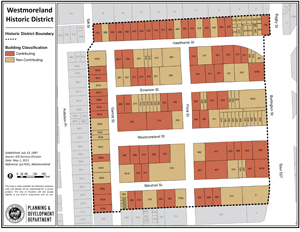

Westmoreland
About
The Westmoreland neighborhood, developed in 1902, is located just southwest of downtown Houston. At the time it was planned and platted, the layout was innovative and it set the standard for exclusive neighborhoods throughout Houston.
Houston had been a major shipping and trade center since its founding in 1836. During the 1800s, city leaders invested in the development of railroads and Houston’s network of bayous. The Houston Ship Channel and Port of Houston were built in the early 1900s. All of this development drove the city’s tremendous growth and between 1900 and 1910, the population doubled.
The City needed new neighborhoods for these new people. Many wealthy professionals who had lived in or near downtown began to move out of downtown into new, exclusive neighborhoods. Several of those neighborhoods were built southwest of downtown. They include Courtlandt Place, Westmoreland, Audobon Place, Avondale, Boulevard Oaks, and Broadacres.
W. W. Baldwin was a lawyer and vice president of the Burlington railroad. Although he lived in Burlington, Iowa, his South End Land Company invested in real estate in Houston. His South End Land Company developed the Westmoreland subdivision, as well as the town of Bellaire.
Baldwin hired Julius Pitzman, an engineer from St. Louis, Missouri, to plan the Westmoreland Addition. He had developed several “private place” neighborhoods in St. Louis and Westmoreland was the first one in Houston. To signal the neighborhood’s status, Pitzman planned a wide central street (Westmoreland Avenue) with cast stone piers and street gates at one end. The streets were surfaced with crushed oyster shells.
Most of the lots in the neighborhood were built out between 1903 and 1913. Westmoreland is unusual because it contains so many houses built in the styles popular during the Victorian era. In most places, new styles of architecture (especially the Craftsman bungalow) took over after 1900, however Westmoreland contains a surprisingly large number of late Victorian, such as Queen Anne, houses. While less numerous, it also contains some of the architectural styles popular later in the early 1900s: Craftsman and Prairie. A second wave of building took place after World War I and most of those houses feature the “Revival” styles popular then: Colonial Revival, Classical Revival, and Italian Renaissance.
The neighborhood was the first in Houston to be developed with deed restrictions. These restrictions specified how far the house had to be set back from the street and that property could be used only for residential purposes, although outhouses and stables were allowed. The restrictions did allow for physicians to have offices in their homes. The deed restrictions also stated that the streets would remain private, unless a majority of residents wanted to make them public. As a result, no streetcars could run in the neighborhood for 20 years. Westmoreland’s deed restrictions also permitted “flats” or apartments; several apartment buildings were constructed in the 1920s.
The neighborhood began to decline in the 1950s and 1960s. During this period, many houses were torn down to make way for large apartment complexes. Even more historic houses were lost when US 59 Spur 527 was built. That construction project destroyed the original street gates and two blocks of houses at the east end of Westmoreland Avenue.
Since the mid-1970s, residents have worked to restore the original houses. They have also built new housing that is compatible with the neighborhood’s historic character.